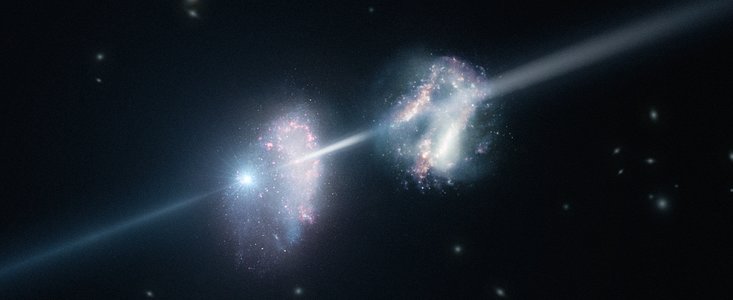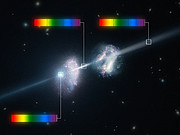Press Release
VLT Observations of Gamma-ray Burst Reveal Surprising Ingredients of Early Galaxies
2 November 2011
An international team of astronomers has used the brief but brilliant light of a distant gamma-ray burst as a probe to study the make-up of very distant galaxies. Surprisingly the new observations, made with ESO’s Very Large Telescope, have revealed two galaxies in the young Universe that are richer in the heavier chemical elements than the Sun. The two galaxies may be in the process of merging. Such events in the early Universe will drive the formation of many new stars and may be the trigger for gamma-ray bursts.
Gamma-ray bursts are the brightest explosions in the Universe [1]. They are first spotted by orbiting observatories that detect the initial short burst of gamma rays. After their positions have been pinned down, they are then immediately studied using large ground-based telescopes that can detect the visible-light and infrared afterglows that the bursts emit over the succeeding hours and days. One such burst, called GRB 090323 [2], was first spotted by the NASA Fermi Gamma-ray Space Telescope. Very soon afterwards it was picked up by the X-ray detector on NASA’s Swift satellite and with the GROND system at the MPG/ESO 2.2-metre telescope in Chile (eso1049) and then studied in great detail using ESO’s Very Large Telescope (VLT) just one day after it exploded.
The VLT observations show that the brilliant light from the gamma-ray burst had passed through its own host galaxy and another galaxy nearby. These galaxies are being seen as they were about 12 billion years ago [3]. Such distant galaxies are very rarely caught in the glare of a gamma-ray burst.
“When we studied the light from this gamma-ray burst we didn’t know what we might find. It was a surprise that the cool gas in these two galaxies in the early Universe proved to have such an unexpected chemical make-up,” explains Sandra Savaglio (Max-Planck Institute for Extraterrestrial Physics, Garching, Germany), lead author of the paper describing the new results. “These galaxies have more heavy elements than have ever been seen in a galaxy so early in the evolution of the Universe. We didn't expect the Universe to be so mature, so chemically evolved, so early on.”
As light from the gamma-ray burst passed through the galaxies, the gas there acted like a filter, and absorbed some of the light from the gamma-ray burst at certain wavelengths. Without the gamma-ray burst these faint galaxies would be invisible. By carefully analysing the tell-tale fingerprints from different chemical elements the team was able to work out the composition of the cool gas in these very distant galaxies, and in particular how rich they were in heavy elements.
It is expected that galaxies in the young Universe will be found to contain smaller amounts of heavier elements than galaxies at the present day, such as the Milky Way. The heavier elements are produced during the lives and deaths of generations of stars, gradually enriching the gas in the galaxies [4]. Astronomers can use the chemical enrichment in galaxies to indicate how far they are through their lives. But the new observations, surprisingly, revealed that some galaxies were already very rich in heavy elements less than two billion years after the Big Bang. Something unthinkable until recently.
The newly discovered pair of young galaxies must be forming new stars at a tremendous rate, to enrich the cool gas so strongly and quickly. As the two galaxies are close to each other they may be in the process of merging, which would also provoke star formation when the gas clouds collide. The new results also support the idea that gamma-ray bursts may be associated with vigorous massive star formation.
Energetic star formation in galaxies like these might have ceased early on in the history of the Universe. Twelve billion years later, at the present time, the remains of such galaxies would contain a large number of stellar remnants such as black holes and cool dwarf stars, forming a hard to detect population of “dead galaxies”, just faint shadows of how they were in their brilliant youths. Finding such corpses in the present day would be a challenge.
“We were very lucky to observe GRB 090323 when it was still sufficiently bright, so that it was possible to obtain spectacularly detailed observations with the VLT. Gamma-ray bursts only stay bright for a very short time and getting good quality data is very hard. We hope to observe these galaxies again in the future when we have much more sensitive instruments, they would make perfect targets for the E-ELT,” concludes Savaglio.
Notes
[1] Gamma-ray bursts lasting longer than two seconds are referred to as long bursts and those with a shorter duration are known as short bursts. Long bursts, including the one in this study, are associated with supernova explosions of massive young stars in star-forming galaxies. Short bursts are not well understood, but are thought to originate from the merger of two compact objects such as neutron stars.
[2] The name refers to the date on which the burst was discovered, in this case it was spotted on 23 March 2009.
[3] The galaxies were seen at a redshift of 3.57, meaning that they are seen as they were 1.8 billion years after the Big Bang.
[4] The material produced by the Big Bang, 13.7 billion years ago, was almost entirely hydrogen and helium. Most heavier elements, such as oxygen, nitrogen and carbon, were produced later by thermonuclear reactions inside stars and fed back into the reserves of gas within galaxies as these stars die. So, it is expected that the amount of heavier elements in most galaxies gradually increases as the Universe ages.
More information
This research was presented in a paper "Super-solar Metal Abundances in Two Galaxies at z ~ 3.57 revealed by the GRB 090323 Afterglow Spectrum" to appear in Monthly Notices of the Royal Astronomical Society.
The team is composed of S. Savaglio (Max Planck Institute for Extraterrestrial Physics, Garching bei München, Germany [MPE]), A. Rau (MPE), J. Greiner (MPE), T. Krühler (MPE; Technische Universität München, Garching, Germany [TUM]; Dark Cosmology Centre, University of Copenhagen, Denmark), S. McBreen (University College Dublin, Ireland; MPE), D. H. Hartmann (Clemson University, Clemson, USA), A. C. Updike (Clemson; Dickinson College, Carlisle, USA), R. Filgas (MPE), S. Klose (Thüringer Landessternwarte Tautenburg, Germany), P. Afonso (MPE), C. Clemens (MPE), A. Küpcü Yoldaş (ESO, Garching, Germany), F. Olivares E. (MPE), V. Sudilovsky (MPE; TUM) and G. Szokoly (Eötvös University, Budapest, Hungary).
ESO, the European Southern Observatory, is the foremost intergovernmental astronomy organisation in Europe and the world’s most productive astronomical observatory. It is supported by 15 countries: Austria, Belgium, Brazil, Czechia, Denmark, France, Finland, Germany, Italy, the Netherlands, Portugal, Spain, Sweden, Switzerland and the United Kingdom. ESO carries out an ambitious programme focused on the design, construction and operation of powerful ground-based observing facilities enabling astronomers to make important scientific discoveries. ESO also plays a leading role in promoting and organising cooperation in astronomical research. ESO operates three unique world-class observing sites in Chile: La Silla, Paranal and Chajnantor. At Paranal, ESO operates the Very Large Telescope, the world’s most advanced visible-light astronomical observatory and two survey telescopes. VISTA works in the infrared and is the world’s largest survey telescope and the VLT Survey Telescope is the largest telescope designed to exclusively survey the skies in visible light. ESO is the European partner of a revolutionary astronomical telescope ALMA, the largest astronomical project in existence. ESO is currently planning a 40-metre-class European Extremely Large optical/near-infrared Telescope, the E-ELT, which will become “the world’s biggest eye on the sky”.
Links
Contacts
Sandra Savaglio
Astronomer, Max Planck Institute for Extraterrestrial Physics
Garching bei München, Germany
Tel: +49 89 30000 3358
Cell: +49 151 5194 4223
Email: savaglio@mpe.mpg.de
Richard Hook
ESO, La Silla, Paranal, E-ELT and Survey Telescopes Public Information Officer
Garching bei München, Germany
Cell: +49 151 1537 3591
Email: rhook@eso.org
About the Release
| Release No.: | eso1143 |
| Name: | Gamma-ray burst |
| Type: | Early Universe : Cosmology : Phenomenon : Gamma Ray Burst |
| Facility: | Very Large Telescope |
| Instruments: | FORS2 |
| Science data: | 2012MNRAS.420..627S |



